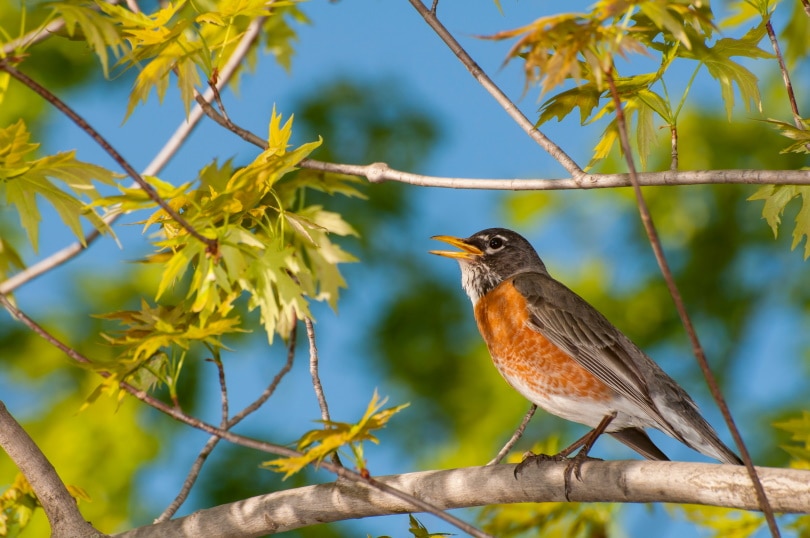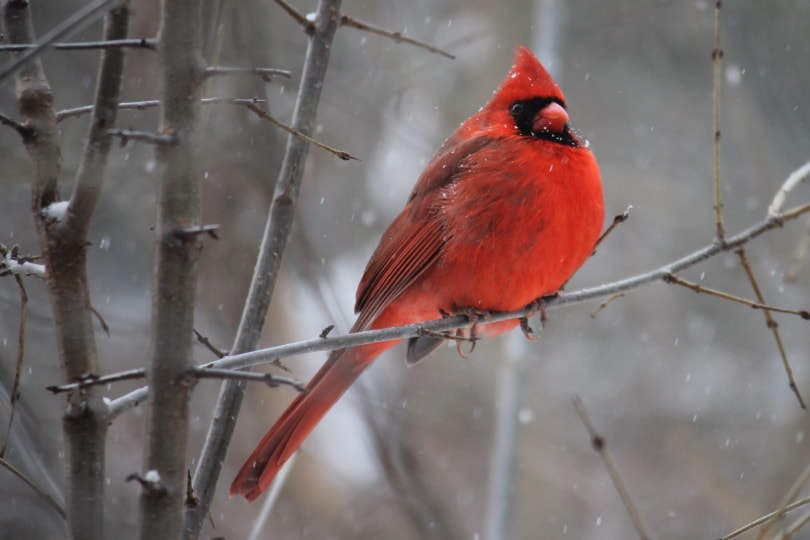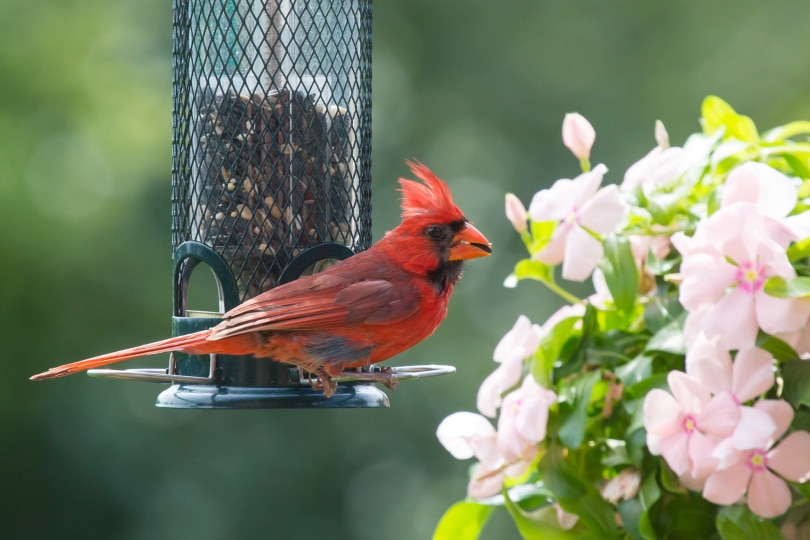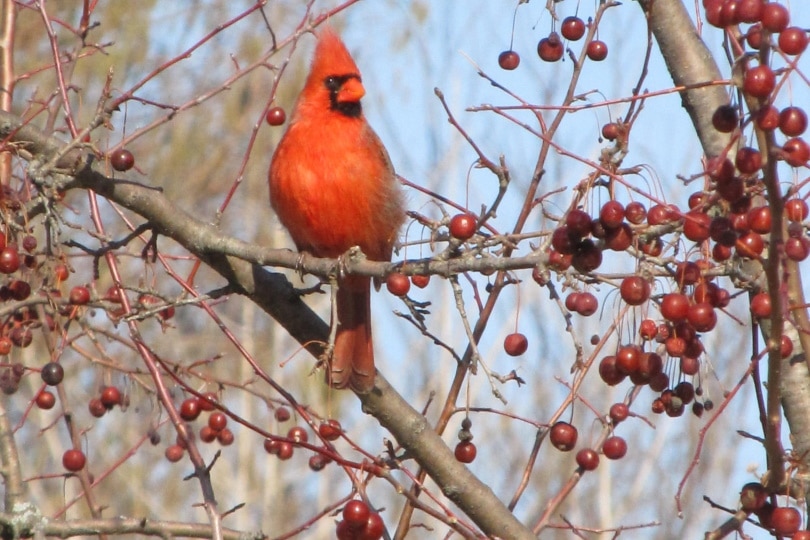Robin vs Cardinal: How to Tell the Difference (With Pictures)
Last Updated on

Robins and cardinals are both lovely-looking birds with pleasing songs and territorial tendencies. Although mixing up these two species can be easy, some differences can help you set them apart. Behavior during mating, breeding, and nesting can be a sure way to determine which species you are observing. If you find a lovely orange bird in your backyard birdfeeder and notice that it is social with other birds and humans, you will most likely have stumbled upon an American robin. Northern cardinals tend to be so territorial that they will fight off their own reflection to protect their nests.
Read through the entire article below to learn basic information on these two birds and easy ways to tell them apart.

Visual Differences

At a Glance
- Origin: North America—from southern Canada to central Mexico
- Size: 9–11 inches
- Average lifespan: 2 years
- Domesticated?: No
- Origin: Southeastern Canada and eastern US, and south of Mexico
- Size: 3–9.1 inches
- Average lifespan: 3 years
- Domesticated?: No

Robin Overview

Characteristics & Appearance
American robins are a common and lovely sight in most residential and rural areas of North America. These fascinating songbirds have beautiful orange plumage, black wings, and a round black head, which makes it easy to recognize them in the wild. Female and male robins have an almost identical appearance, the only difference being the sometimes dull colors on the female’s body.
Male robins have a lovely and cheerful song that you can frequently hear before and after sunrise, at dusk, and before the rain. Robins prefer to nest in woodlands and grasslands with shrubs; they can be found year-round in rural and suburban areas such as parks, backyards, and pastures.

Diet
The diet of a robin is various and flexible. During summer and spring, they mainly depend on insects such as earthworms, while during winter, when it’s harder to find prey, they will feed on berries, fruits, and seeds. Fruits that robins prefer include hawthorn, dogwood, juniper berries, and chokecherries.
Sometimes, robins selectively eat seeds or berries with insects to round out their diet. They hop around city parks, gardens, and lawns, often in flocks, foraging for food. Putting bird feeders in your backyard is a way to attract robins, as they are also a common sight near them.

Cardinal Overview

Characteristics & Appearance
The northern cardinal is one of North America’s most recognized and widely spread birds. These small to medium-sized songbirds are easily recognizable. These birds have a distinctive bright red pigment from their unique dietary choices. They mainly consume berries and seeds with carotenoid pigments that convert to the red color of their feathers in their adult lives.
What is special about cardinals is that not all of these birds carry the bright red pigment. Some cardinals have a genetic defect called xanthochroism, which makes these unique birds have a bright yellow color on their feathers. Cardinals tend to pair for life and are very devoted to defending their nest and territory.
Diet
Cardinals’ diet primarily consists of seeds and berries. Even though cardinals are granivorous, they rely on eating insects for rapid growth when they are young—young cardinals feed exclusively on insects. Cardinals are common guests to backyard feeders, feeding on sunflower seeds. Northern cardinals will remain in the north of America without migrating to the south, especially if the birdfeeders sustain them throughout the winter.
Cardinals forage for food by hopping on the ground and around bushes in search of fallen berries or seeds. The seeds they prefer include those from pine trees, foxtail, thistle, buttonweed, and other grasses; the berries and fruits they love to eat include blackberries, raspberries, cherries, and grapes.


What Are the Differences Between Robins & Cardinals?
Appearance
When it comes to the appearance of these two birds, it is straightforward to tell them apart. American robins have dark black heads and wings, while their chests are colored in vivid rusty orange. The female robin will have the same color pattern, in slightly washed-out shades.
On the other hand, cardinals have a unique color pattern that you can only see in a few other species worldwide. They possess a particular pigment that comes from the berries and fruits they digest, which makes their feathers have a bright red color. The female cardinal will have a slightly dim shade of red that appears pale brown.
Robins also tend to be larger than cardinals and carry more weight. Their body has an overall round shape, while cardinals have a distinctive pointed thrush of feathers on their heads.

Behavior
These lovely birds tend to get territorial when defending their females and nests. Even though robins are territorial, they are much more social with other birds than cardinals. Northern cardinals are solitary birds that enjoy living in pairs, especially during mating season. During winter, robins enjoy staying in flocks, while cardinals will separate into pairs.
American robins are extremely industrious birds, which is a vast difference compared to cardinals, that enjoy peace, sitting quietly in low shrubs.
Nesting
When it comes to nest building, the primary difference between these two birds is that the female robin is responsible for building nests alone. In contrast, the female and the male cardinals will work together to accomplish this goal.
One similarity these birds have is that both the robin and cardinal females will lay two or three clutches each year. Northern cardinals will lay beautiful white and pale-gray eggs with distinctive speckles. The young cardinals grow up fast and leave the nest only 7 to 13 days after hatching.
On the other hand, the American robin lays stunning bright-blue eggs without any markings on them. The brightness of the blue color indicated how healthy the female robin is. The nestlings are born featherless, with translucent yellow skin, and it takes them about 14 days to reach adulthood.


Conclusion
The robin and the cardinal are fascinating birds with many differences and similarities. Robins and cardinals have almost identical songs and calls and similar color patterns. Learning the roles that males and females maintain during specific periods can be a helpful way to differentiate these two species.
Female robins build nests independently, with minimal help from their mates, while cardinal pairs will build the nests together. Being able to tell these two birds apart is rewarding, but it isn’t always that straightforward, so hopefully, after this article, you’ll be able to tell them apart easily.
- You might also like: Oriole vs Robin: How To Tell the Difference
Featured Image Credit: (L) Jukka Jantunen, Shutterstock, (R) FotoRequest, Shutterstock
About the Author Robert Sparks
Robert’s obsession with all things optical started early in life, when his optician father would bring home prototypes for Robert to play with. Nowadays, Robert is dedicated to helping others find the right optics for their needs. His hobbies include astronomy, astrophysics, and model building. Originally from Newark, NJ, he resides in Santa Fe, New Mexico, where the nighttime skies are filled with glittering stars.
Related Articles:
Monocular vs Telescope: Differences Explained (With Pictures)
How to Clean a Refractor Telescope: Step-by-Step Guide
How to Clean a Telescope Eyepiece: Step-by-Step Guide
How to Clean a Rifle Scope: 8 Expert Tips
What Is a Monocular Used For? 8 Common Functions
How to Clean a Telescope Mirror: 8 Expert Tips
Brightfield vs Phase Contrast Microscopy: The Differences Explained
SkyCamHD Drone Review: Pros, Cons, FAQ, & Verdict
